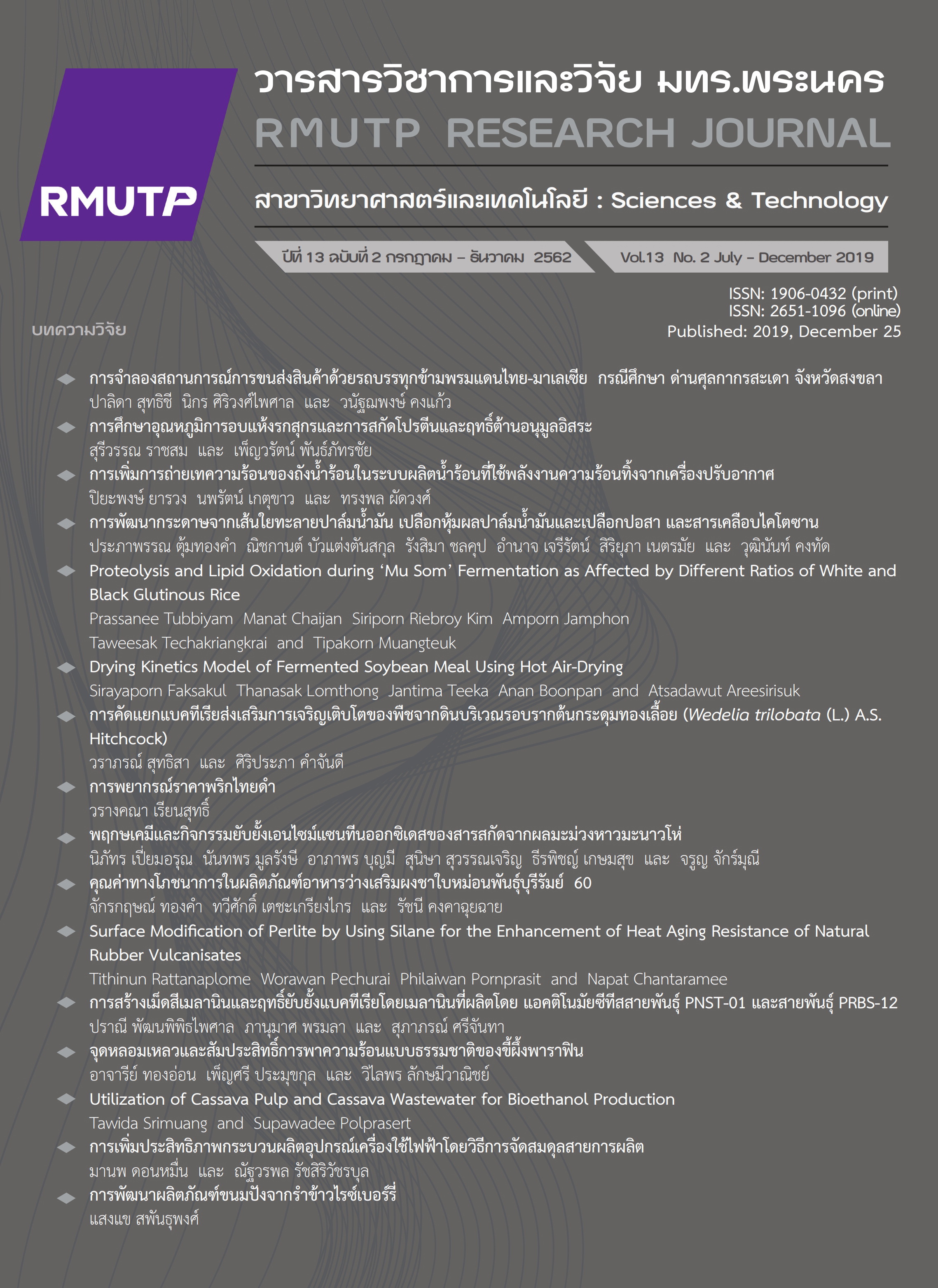Surface Modification of Perlite by Using Silane for the Enhancement of Heat Aging Resistance of Natural Rubber Vulcanisates
Main Article Content
Abstract
Our previous work reported that 30 phr of natural silica in perlite particles were potentially used as odor-adsorbing filler in natural rubber vulcanisates but resulting in low mechanical properties. The enhancement of mechanical properties of natural rubber vulcanisates was expected by surface modification of perlite particles. Thus, the objective of the present study is to investigate the heat aging resistance properties in terms of stress at 100% elongation, tensile strength, and percentage elongation at break after surface modification. Furthermore, the rebound resilience and abrasion resistance of perlite treated with silane filled in NR vulcanisates will be investigated. In a comparison, the properties of clay-filled NR vulcanisates will be determined. From the experiments, it was found that surface modifications using silane gave better perlite-NR interactions before and after aging. The better heat resistance properties of perlite-filled NR vulcanisates than those of clay-filled vulcanisates can be detected from relative property data. Nevertheless, a lower percentage of rebound resilience and abrasion resistance of perlite-filled vulcanisates before and after surface modification than those of clay-filled vulcanisates can be observed. This is owing to the large particle size, low surface area, poor dispersion, and agglomeration of perlite in NR vulcanisates. Perlite particles with high silica content are potentially used as odor-adsorbing filler in natural rubber (NR) vulcanisates but not as reinforcement filler.
Article Details
References
[2] V.P Hoven, K. Rattanakarun, and Y. Tanaka, “Reduction of offensive odor from natural rubber by odor-reducing substances” Journal of Applied Polymer Science. vol. 92, pp. 2253-2260, May. 2004
[3] T. Rattanaplome, S. Kajitpeatjarat, S. Ariya, and N. Chantaramee, “The effect of odor-adsorbing fillers on mechanical properties of natural rubber vulcanizates” Journal of interdisciplinary network, vol. 2 (special issue), pp. 203-210, Jul.-Dec., 2013
[4] T. Rattanaplome, N. Chantaramee, and P. Pornprasit, “The potential of perlite as an odour-adsorbing fillers in natural vulcanizates” Macromolecular Symposium, vol. 354, no. 1, pp. 197-206, Aug., 2015
[5] T. Rattanaplome, P. Pornprasit, and N. Chantaramee, “Utilization of perlite as an odor-reducing filler in natural rubber vulcanizates”, in Proceeding of the second Asia Pacific Rubber Conference (APRC) , Prince of Songkla University, Surathani Campus, Thailand, 2015, pp. 195-205
[6] P. Sae-oui, C. Sirisinha, U. Thepsuwan, and K. Hattthapanit, “Comparison of reinforcing efficiency between Si-69 and Si-624 in a conventional vulcanization system” Polymer Testing, vol. 23, no.8, pp. 871-879, Dec. 2004
[7] S. Thongsang, and N. Sombatsompop, N., “Effect of NaOH and Si69 treatments on the properties of fly ash/natural rubber composites”, Polymer Composites, vol. 27, no. 1, pp. 30-39, Feb. 2006
[8] I. Surya, H. Ismail, and A. R. Azura, “Alkanolamide as an accelerator, filler-dispersant and a platicizer in silica-filled natural rubber compounds”, Polymer Testing, Vol. 32, no.8, pp. 1313-1321, Dec. 2013
[9] Y. Li, B. Han, S. Wen, Y. Lu, H. Yang, L. Zhang, and L. Liua, “Effect of the temperature on surface modification of silica and properties of modified silica filled rubber composites”. Composites Part A: Applied Science and Manufacturing , vol. 62, pp. 52-69, Jul. 2014
[10] F.R. Lamastra, S. Mori, V. Cherubini, M. Scarselli, F. Nanni, “A new green methodology for surface modification of diatomite filler in elastomers”, Materials Chemistry and Physics, vol. 194, pp. 253-260, Jun.2017
[11] D. Moonchai, N. Moryadee, and N. Poosodsang, “Comparative properties of natural rubber vulcanisates filled with defatted rice bran, clay and calcium carbonate”, Maejo International Journal of Science and Technology, vol. 6, no. 2 , pp. 249-258, Jul. 2012
[12] S. Moonchai, and D. Moonchai, “Modelling and optimization of rebound resilience and hardness of defatted rice bran/calcium carbonate-filled NR vulcanisates”, Polymer Testing, vol. 32, no.8, pp. 1472-1478, Dec. 2013
[13] N. Rattanasom, T. Saowapark, and C. Deeprasertkul, C., “Reinforcement of natural rubber with silica/carbon black hybrid filler”, Polymer Testing, vol. 26, no.3, pp. 369-377, May, 2007


